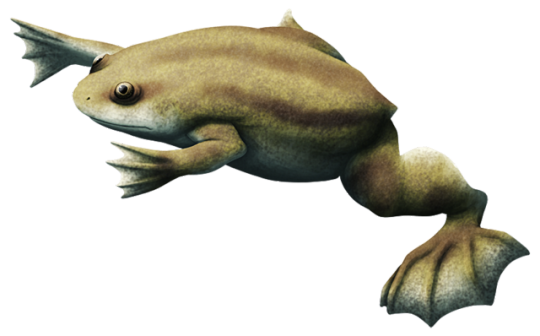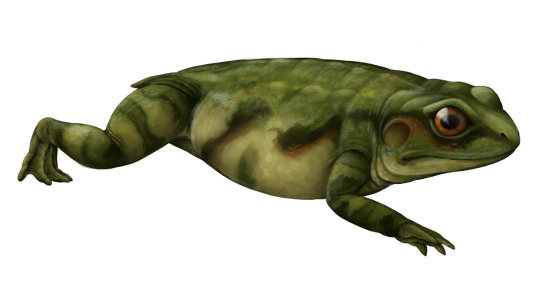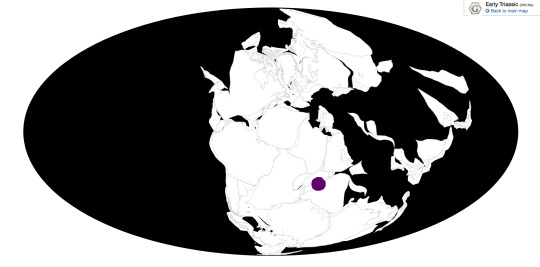#salientia
Explore tagged Tumblr posts
Photo

🐸 Catalogue of the Batrachia Salientia and Apoda (frogs, toads, and cœcilians) of southern India /. Madras: Superintendent, Government Press, 1888.
77 notes
·
View notes
Text




Salientia Crapaud
#ts2 build#ts2 decor#ts2 interior#ts2 exterior#sims 2 pictures#ts2 pictures#ts2#sims 2#sims2#the sims 2
78 notes
·
View notes
Text

Photobash art I made for a friend's joke song
4 notes
·
View notes
Text

Notobatrachus
Notobatrachus (лат.) – рід вимерлих земноводних з надряду Salientia. Представники роду жили в середньо-юрську епоху (келовейський-батський віки, 168,3-163,5 млн років тому) в Південній Америці (Патагонія, Аргентина), тобто хронологічно ближче до сучасних безхвостих, ніж найдавніші жаби з родів Prosalirus і Vieraella.
Повний текст на сайті "Вимерлий світ":
https://extinctworld.in.ua/notobatrachus/
Дякуємо всім за підтримку, для наших патронів на Patreon вже доступний невеликий дарунок (календар для друку).
Підтримуйте нас на Patreon:
https://www.patreon.com/extinctworld
Підписуйтесь на наш телеграм-канал:
https://t.me/extinct_world
Підтримуйте нас на ko-fi:
https://ko-fi.com/extinctworld
#notobatrachus#patagonia#argentina#south america#jurassic#salientia#prosalirus#vieraella#paleontology#paleoart#prehistoric#extinct animals#доісторичні тварини#палеоарт#палеонтологія#вимерлі тварини#ukraine#ukraineposts#made in ukraine
2 notes
·
View notes
Photo







Snaturday! Here’s the ladies and my frog collection (Top: Hibiscus, Tarragon, Wisteria. Middle: Frog, Toad. Bottom: Anura, Bufo)
#fr dragon share#fr#i don actually have all the froggy companion apparel for bufo and anura yet but#i want it#im a simple person: i see people taking part in snapper sharing. i immediately join in#i also dont have any faes to share today so... Snappers!!#salientia
25 notes
·
View notes
Photo






Frogs Anura
#frogs#frog#anura#amphibians#herps#herpetology#nature#wildlife#wildlife biology#biodiversity#diversity#different#evolution#salientia#animals#animalia#zoology
1K notes
·
View notes
Photo

Almost-Living Fossils Month #25 -- Europe’s Fully Aquatic Frogs
The palaeobatrachids were a group of frogs, part of a fairly “primitive” lineage that also includes the living pipids. They first appeared in the fossil record about 70 million years ago in the Late Cretaceous, but may have actually originated much earlier, perhaps as far back as the Late Jurassic (~145 mya).
These frogs lived mainly in Europe, with a few possible remains also known from North America in the Cretaceous. They were fully aquatic, spending their entire lives in water, and fully-grown adults looked similar to modern Xenopus clawed frogs, with slightly flattened egg-shaped bodies, upwards-facing eyes, and long fingers and toes.
Some fossils preserve soft-tissue impressions, showing internal organs such as unusual bag-shaped lungs. Eggs and juveniles have also been found, and while most species’ tadpoles usually reached lengths of around 6cm (2.4″), a few were comparatively gigantic, growing to over twice that size.
The end-Cretaceous extinction (~66 mya) had little overall effect on the palaeobatrachids, and they continued to thrive in the warm wet environments of Europe during the early Cenozoic. But as climates in Western Europe gradually became drier and cooler starting in the Early Oligocene (~33 mya) they mostly disappeared from that region and instead shifted east towards Central and Eastern Europe, ranging as far as Russia.
By the Late Pliocene (~3 mya) they were struggling to cope with the ongoing cooling and drying, and the onset of the Pleistocene glaciations made things even worse for them.
Palaeobatrachus langhae was probably the last species of these frogs, known from the Early Pliocene to the mid-Pleistocene (~5 mya - 500,000 years ago). Growing to about 10cm long (4″), it lived in some of the final refuges of the palaeobatrachids in Eastern Europe, inhabiting inland temperate areas where winter temperatures weren’t too harsh.
Unfortunately the palaeobatrachids didn’t quite manage to make it through the Ice Age, ending up trapped by their fairly specialized habitat preferences. During repeated glacial periods the temperatures became too cold for them, freezing the water they depended on, but the warmer climates to the south were also too dry for them to migrate into -- and with nowhere to go, they finally went completely extinct just half a million years ago.
#almost living fossils month#science illustration#paleontology#paleoart#palaeoblr#palaeobatrachus#palaeobatrachidae#pipimorpha#anura#frog#salientia#batrachia#lissamphibia#amphibian#art
163 notes
·
View notes
Photo


Can you find the froggies?
#Animalia#Chordata#Amphibia#Salientia#Anura#wildlife#Black Bayou Lake National Wildlife Refuge#okay the first one might not be so hard to spot#nature photography#nikonphotography#photographers on tumblr#Nikon D3400
1 note
·
View note
Photo

🐸 Catalogue of the Batrachia Salientia and Apoda (frogs, toads, and cœcilians) of southern India /. Madras: Superintendent, Government Press, 1888.
22 notes
·
View notes
Photo



🐸 THEY’RE COMING!!! 🐸
Only Samurai Jack fans will get the title.
4 notes
·
View notes
Text

the kids are complete
#rwby oc#theyre based loosley on disney princesses#but like also on the main villain at the same time#they should all be decently obvious except ichor#might have to think harder to work their ellusion out#also ghgh yes i know mith/myth isnt a colour#let me pretend its short for lotr mithtil or something ghghg#theyre all from atlus btw thats why theyre dressed so warm™️#salientia was the hardest to design idk why#she just goes by ‘tia’#also mauveines shirt says ‘chill’ and not ‘child’ like i keep accidentally reading it gjghg#do you guys care about my ocs? absouletly not but fuck it
5 notes
·
View notes
Note
Is my brain totally malfunctioning or salientia a really badass name if you don't the what it stands for,,,,,,,,,,,
I Googled it and it said that salientia is “an order of tailless amphibians that comprises the frogs and toads” lol
9 notes
·
View notes
Text
Triadobatrachus massinoti

By Scott Reid
Etymology: Triassic frog
First Described By: Piveteau, 1936
Classification: Biota, Archaea, Proteoarchaeota, Asgardarchaeota, Eukaryota, Neokaryota, Scotokaryota Opimoda, Podiata, Amorphea, Obazoa, Opisthokonta, Holozoa, Filozoa, Choanozoa, Animalia, Eumetazoa, Parahoxozoa, Bilateria, Nephrozoa, Deuterostomia, Chordata, Olfactores, Vertebrata, Craniata, Gnathostomata, Eugnathostomata, Osteichthyes, Sarcopterygii, Rhipidistia, Tetrapodomorpha, Eotetrapodiformes, Elpistostegalia, Stegocephalia, Temnospondyli, Euskelia, Dissorophoidea, Xerodromes, Amphibamiformes, Lissamphibia, Batrachia, Salientia, Triadobatrachidae
Referred Species: T. massinoti
Status: Extinct
Time and Place: Approximately 251–250 million years ago, in the late Induan to early Olenekian of the Early Triassic.

Triadobatrachus is only known from the Sakamena Formation in Northern Madagascar.

Physical Description: Triadobatrachus superficially resembles modern frogs, it was only around 10 cm long, had a broad head and a very reduced tail. Its skeleton had many features associated only with frogs among amphibians, including a very frog-like skull with big eyes and their characteristically elongated hips. Soft tissues preserved around the fossil even show that it had the wide, round body of frogs too. However, the skeleton of Triadobatrachus differed from living frogs in a few major ways. It had much more vertebrae than living frogs, 26 compared to the maximum 4–9 of frogs alive today, giving it a much longer body, and these vertebrae had ribs, unlike living frogs. Its legs were shorter and more squat, especially its back legs, which were hardly any longer than its front ones, making Triadobatrachus incapable of hopping despite its derived hips. Even the stumpy tail was still more prominent than in living frogs, and may have even retained some degree of mobility. To sum it up, Triadobatrachus more or less looked like a stretched out frog with short legs. Think of a horned toad lizard but with more of the toad part and less horned.
Diet: Like other frogs, Triadobatrachus was probably carnivorous, likely feeding on invertebrates like insects and other arthropods, molluscs, worms, and perhaps even any small vertebrates it could fit in its mouth.
Behavior: One of the most standout features of Triadobatrachus is that it couldn’t have hopped like modern frogs. Instead, Triadobatrachus would have walked around on land more like a salamander, although it is unknown just how much time it would have spent on land in the first place anyway. It was clearly amphibious, and it probably swam by kicking its back legs like frogs, unlike the undulation of newts and salamanders. It would have spawned like living amphibians too, laying shell-less eggs in water that hatched into tadpoles and underwent metamorphosis just like modern frogs. Otherwise, its behaviour is a mystery. We don’t even know if it would have croaked or not.
Ecosystem: Not much is directly known about the ecosystem Triadobatrachus inhabited, as the only known fossil had been washed out to sea along the coast. The intact body at least implies the body wasn’t transported far, so Triadobatrachus probably lived in coastal floodplain rivers and swamps. Various other temnospondyl amphibians are known from the area, including Edingeralla, Deltacephalus, Mahavisaurus, Wantzsosaurus and Tertremoides. Despite being amphibians, many of these temnospondyls were likely euryhaline, meaning they could tolerate salt water and inhabited the coastline, something only a few living amphibians are even remotely capable of standing. The peculiar aquatic reptile Hovasaurus lived along the coasts, although it’s unknown if it ever crossed paths with the freshwater frogs, and terrestrial procolophonid parareptiles were also present. Plant remains suggest the environment was tropical and semi-arid with a monsoonal climate that supported conifer forests along with seed ferns, horsetails and clubmosses.
Other: Triadobatrachus is one of the only known stem-frogs, along with the polish Czatkobatrachus, and is certainly the oldest. The early evolution of Lissamphibia (all living amphibians) is poorly understood, particularly whether their ancestry lies in the temnospondyls or some other “amphibians”. Triadobatrachus doesn’t solve this debate, although it does show similarities to the Permian amphibamiforms like Gerobatrachus, supporting the temnospondyl affinity for batrachians (the frogs and salamanders) amongst dissorophoids.
Before they were considered to be temnospondyls, lissamphibians were often thought to be lepospondyls, a probably paraphyletic or even polyphyletic (i.e. unnatural) collection of “amphibians” on the tetrapod tree more derived than temnospondyls (some may even be honest to goodness amniotes!). This picture is complicated by caecilians, which at one point were suggested to be lepospondyls while batrachians were temnospondyls, making Lissamphibia polyphyletic! The story got even stranger after a little Triassic amphibian, Chinlestegophis, was discovered in 2017 and was considered to be a stem-caecilian. Chinlestegophis pulled caecilians back into temnospondyls with the other lissamphibians, but at almost opposite ends of the temnospondyl tree—batrachians in amphibamiforms and caecilians in with the stereospondyls related to the giant metoposaurs! So lissamphibians may all be temnospondyls...but also polyphyletic, unless nearly all of Temnospondyli is classed as lissamphibians and becomes part of the crown group. This would also mean our small modern amphibians both independently miniaturised from the much larger, classic predatory amphibians of the Palaeozoic and Triassic. What a concept.
Regardless of temnospondyl taxonomic troubles, Triadobatrachus is a perfect transitional form from more generalised amphibians to the highly specialised anatomy of frogs. Particularly, it shows that some of their unique anatomical adaptations evolved before they were able to hop, and may have functioned for other activities like swimming. The almost complete preservation of a skeleton as delicate as one of a small amphibian is a remarkable find, let alone one that represents a perfect transitional form for a group of animals whose evolutionary history is shrouded in mystery, and makes Triadobatrachus a fantastic find, no matter how unassuming it may be.
~ By Scott Reid
Sources under the Cut
Ascarrunz, Eduardo; Rage, Jean-Claude; Legreneur, Pierre; Laurin, Michel (2016). "Triadobatrachus massinoti, the earliest known lissamphibian (Vertebrata: Tetrapoda) re-examined by µCT-Scan, and the evolution of trunk length in batrachians". Contributions to Zoology. 58 (2): 201–234.
Lires, A. I., Soto, I. M., & Gómez, R. O. (2016). Walk before you jump: new insights on early frog locomotion from the oldest known salientian. Paleobiology, 42(4), 612-623.
Maganuco, S., Steyer, J.S., Pasini, G., Boulay, M., Lorrain, S., Bénéteau, A., Auditore, M. (2009). “An exquisite specimen of Edingerella madagascarensis (Temnospondyli) from the Lower Triassic of NW Madagascar; cranial anatomy, phylogeny, and restorations”. Società italiana di scienze naturali.
Pardo, Jason D.; Small, Bryan J.; Huttenlocker, Adam K. (2017-07-03). "Stem caecilian from the Triassic of Colorado sheds light on the origins of Lissamphibia". Proceedings of the National Academy of Sciences. 114 (27): E5389–E5395
Piveteau, J. (1936). "Une forme ancestrale des amphibiens anoures dans le Trias inférieur de Madagascar". Comptes Rendus Hebdomadaires des Séances de l'Académie des Sciences. 202: 1607–1608.
Rage,J-C; Roček, Z. (1989). "Redescription of Triadobatrachus massinoti (Piveteau, 1936) an anuran amphibian from the Early Triassic". Palaeontographica Abteilung A. 206: 1–16.
Roček , Z., Rage, J-C. (2000). "13. Proanuran Stages (Triadobatrachus, Czatkobatrachus)". In Heatwole, H.; Carroll, R. L. (eds.). Amphibian Biology. Paleontology: The Evolutionary History of Amphibians. 4. Surrey Beatty & Sons. pp. 1284–1294.
Ročková, H., Roček Z. (2005). “Development of the pelvis and posterior part of the vertebral column in the Anura”. Journal of Anatomy. 206(1): 17–35.
Xing, L., Stanley, E. L., Bai, M., & Blackburn, D. C. (2018). “The earliest direct evidence of frogs in wet tropical forests from Cretaceous Burmese amber”. Scientific reports, 8(1), 8770.
#Triadobatrachus#Triadobatrachus massinoti#Frog#Palaeoblr#Triassic Madness#Triassic March Madness#Triassic#Prehistory#Paleontology#Prehistoric life
157 notes
·
View notes
Text
Ah thank you so much!! This is so sweet!
Lair review for owleics
Happy franniversary @owleics-fr!!! I went through your lair and picked some of my fave dragons to talk about! under the read more c:
Keep reading
#🥺🥺🥺🥺#to wake up to this in the morning is the best#im super glad my dressing efforts on my newer dragons pay off#and salientia is my fav tab did you know it refers to all froggy amphibians and it means to jump?#i love them#and i love this too!#expect a return.... soon! ;D
7 notes
·
View notes
Photo

some quick and fun designs of bufo and anura! anura is a local witch uhh apothercarist and bufo is a new farm hand who often finds himself set with the taks of delivering requests to anura!
#head full bufo and anura thoughts#toad and frog are the familiars! ironically enough anura ends up with toad and bufo with frog#owl's lore#salientia lore#the are designs based on fr dragons btw!#hence why its posted here I haven't just lost my mind#also theyre lesbians!!#...harold...
5 notes
·
View notes
Photo




Critically Endangered Frogs
From Above: Costa Rican Variable Harlequin Toad, Panamanian Golden Frog, Golden Mantella, Lemur Leaf Frog
#frogs#amphibia#amphibians#herps#conservation#wildlife#wildlife conservation#endangered#endangered species#critically endangered#biodiversity#salientia#anura
108 notes
·
View notes